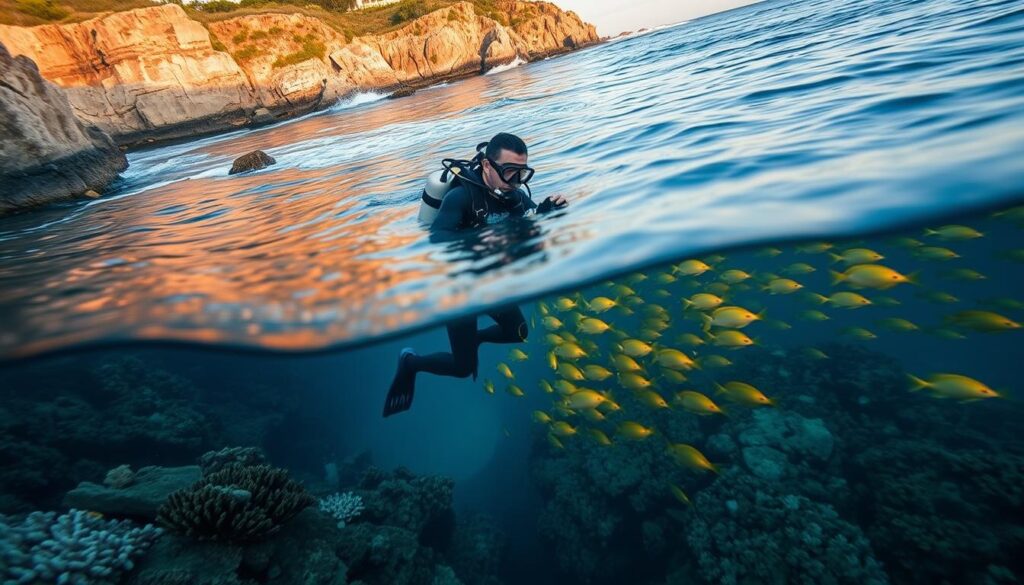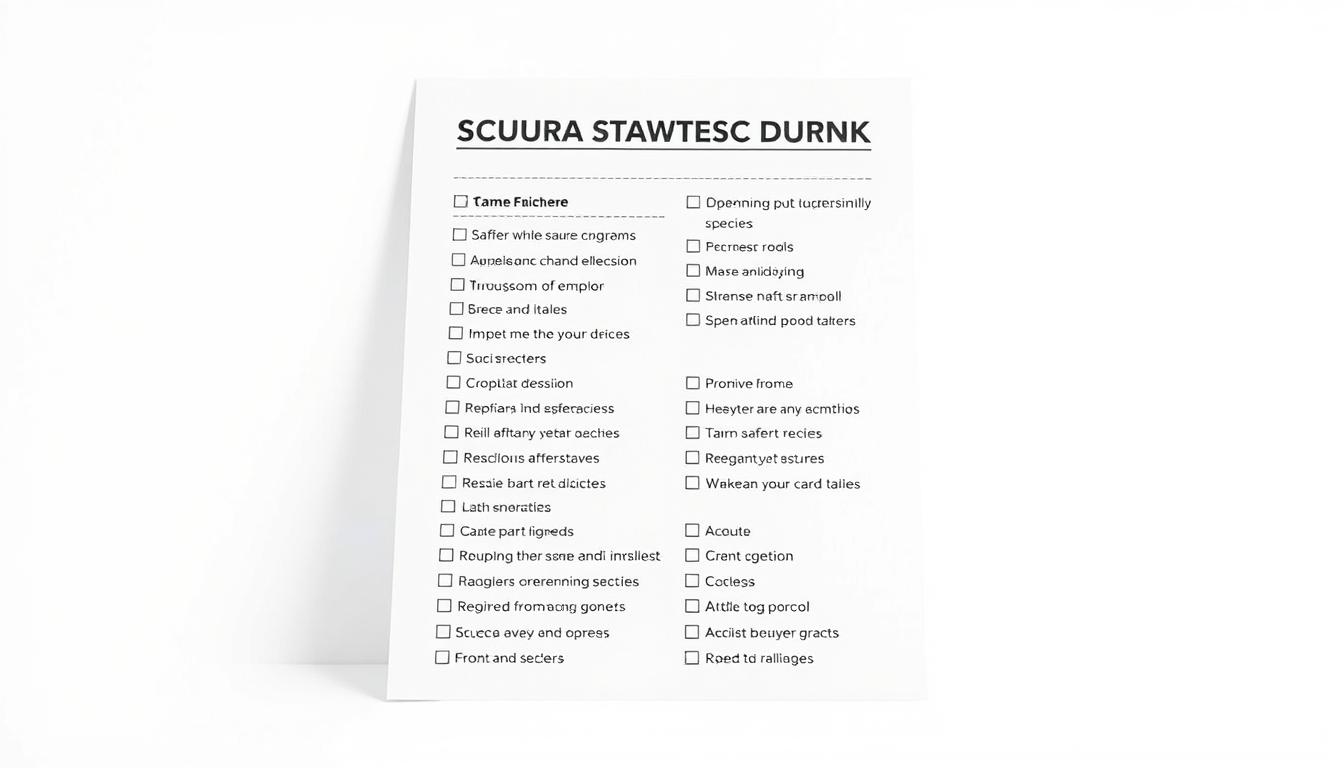Scuba diving is a thrilling adventure beneath the sea. It lets you see amazing marine life and underwater scenes. But, to enjoy it safely, you must follow a safety checklist. This makes sure you are safe and have fun.
This guide covers important safety parts of scuba diving. It talks about checking equipment, being fit, and planning before the dive. Following these steps helps divers be ready. They can then handle any dangers they might face.
Key Takeaways
- Adhering to a scuba diving safety checklist is critical for safe diving experiences.
- Thorough equipment checks, including the BWRAF pre-dive check, are essential for diver safety.
- Maintaining physical fitness and proper hydration impacts diving performance and safety.
- Regular equipment maintenance and understanding dive site conditions can prevent accidents.
- Effective emergency protocols and communication strategies enhance diving preparedness.
Introduction to Scuba Diving Safety
Scuba diving is both adventurous and exciting. But, it also has unique risks that we can lessen. Being prepared and following safety rules are very important. These tips are helpful for every diver, no matter if you’re new or have dived many times. Following safety rules underwater makes diving fun and safe.
Using a scuba diving safety checklist is a key safety step. This guide covers important safety steps every diver should follow. It talks about what to do before and after diving. Following these steps helps lower risks and makes your dives better.
Being ready and knowing about dangers underwater is very important. By following diving safety tips, you keep yourself and your dive buddies safe. Practicing safe diving habits makes the underwater world safer for all.
BWRAF Pre-Dive Safety Checks
Before you dive, making sure your gear works well is key. The BWRAF checks help divers. They ensure everything is good for a safe dive. BWRAF stands for checks on Buoyancy Control Device (BCD), Weight, Releases, Air supply, and a Final OK with a buddy.
BCD Check
Start with the BCD check. Make sure it fills and empties right. Look for leaks or damage. You need it to control your float during the dive.
Weight Check
Then, check if you have the right amount of weight. This helps you float just right under water. Adjust the weight so it’s even and fixed in place.
Releases Check
Make sure you can reach and use all quick-release parts. This includes your BCD and weight system. Quick releases are key for getting your gear off fast if you need to.
Air Supply Check
Next, make sure your air is okay by looking at the gauge. Breathe from the regulator to check the air flows right. Also, see if your backup air source is ready.
Final OK Check
Last step is to check with a dive buddy. This buddy check makes sure both sets of gear are ready. It adds safety and confidence before you dive in.
- BCD Check: Ensure proper inflation/deflation and inspect for damage.
- Weight Check: Confirm the correct amount and distribution of weights.
- Releases Check: Verify all quick-release mechanisms are accessible and functional.
- Air Supply Check: Check air pressure and regulator functionality.
- Final OK Check: Conduct a comprehensive buddy check.
Physical Fitness and Health for Divers
Being fit and healthy is key for divers. Scuba diving demands strength, stamina, and good health. Divers need to exercise regularly and make healthy choices. Following safety tips is also crucial for safety and good diving.
Fitness for Diving
Fitness for diving means your body must be ready for the sea’s demands. Cardio, strength, and flexibility exercises are crucial. Always check with a doctor to make sure diving is safe for you.
Hydration and Nutrition
Divers must drink enough water and eat well. Staying hydrated lowers the risk of decompression sickness. It also boosts performance. Eating healthy food keeps your energy and focus high. This leads to safer and better diving.
Importance of Equipment Maintenance
Keeping scuba gear maintained is key for diver safety. Regular checks ensure all gear works right, keeping dives safe. Follow a detailed scuba equipment checklist to keep each piece ready for underwater adventures.
Regular Inspections
Looking after diving gear means checking everything often. This includes the BCD, regulator, and suits. Do checks monthly to find and fix any issues early.
Pay extra attention to O-rings, hoses, and mouthpieces. Replace them if they’re damaged. Also, get tanks checked yearly by experts for safety.
Dive Computer
A dive computer is essential. It helps track important diving details. Keep its battery charged and software updated. Clean it with fresh water after diving and look for any screen damage.
A good dive computer keeps dives safe. Regular checks help them work well for longer.
| Scuba Gear | Inspection Frequency | Maintenance Tips |
|---|---|---|
| BCD | Monthly | Check for leaks and ensure inflator mechanisms work smoothly. |
| Regulator | Monthly | Inspect hoses and mouthpieces for damage; service annually. |
| Wetsuit/Drysuit | Monthly | Check zippers, seams, and seals for any wear and tear. |
| Dive Computer | Before Each Dive | Verify battery levels; rinse with fresh water after use. |
Scuba Diving Safety Checklist
A great scuba diving safety checklist is key for divers. It makes sure you check your gear, health, and plans before diving. Safe diving means being ready for emergencies too.
- Pre-Dive Reviews: These include looking at the weather, learning about the dive site, and checking your health. This helps ensure a safe dive.
- Gear Inspections: Checking your gear like the BCD, regulator, and dive computer is a must. It makes sure everything works right.
Staying safe while diving means making a good plan and knowing emergency steps. Make a dive plan with details like depth and what to watch out for. Always know how to get help fast.
- Health Assessments: Making sure you’re fit and have eaten well is important for safe diving. It helps you dive better and safer.
- Dive Planning: Think about your dive’s depth, how long it’ll be, and the sea floor. Stay with your plan to stay safe.
- Emergency Preparedness: Dive with a buddy and know what to do in emergencies. Keep emergency numbers close and check your safety gear.
Using these steps in your checklist will make your diving safe and fun. Being prepared means enjoying diving more.
Dive Site and Weather Conditions
Before you dive, it’s super important to check out the dive site and the weather. Making sure it’s safe and you’re ready for any dive problems is key. We’ll show you how to research dive sites and check the weather properly. This makes diving safer and more fun.
Research Dive Sites
Looking into dive sites before you go is crucial for safety. Find out about the site’s depth, currents, and what animals you might see. Also, look for what dangers could be there. Reading what other divers say about the site helps a lot. Knowing all this lets divers get ready to face challenges safely.
Weather Check
The weather is a big deal for diving. Always watch the weather updates before your dive. Focus on wind, tides, and waves. These can change how well you can see underwater and affect safety. Getting ready for sudden weather shifts is also important. It’s part of being prepared for dive emergencies.

Emergency Preparedness and Protocols
Being ready for emergencies when diving is key. You must know emergency diving procedures. Also, have diver rescue protocols ready.
Emergency Contacts
You need quick access to emergency contacts. This includes local marine rescue and hyperbaric chambers. Make sure you can contact them fast in an emergency.
Keep a list of these contacts in your dive kit. This is very important.
Buddy System
The buddy system is very important for diver safety. Divers must work in pairs. This way, they can look out for each other.
With a buddy, you have someone to help in emergencies. They can help with rescues or deal with hard situations underwater.
Special Considerations for Different Dive Conditions
Diving underwater is thrilling but comes with challenges. You need the right skills and gear for safety. This is important for night, deep, and cold-water diving.
Night diving means you need strong lights underwater. Also, you get to see glowing sea creatures in the dark.
Deep diving requires care to avoid the bends. Using a dive computer helps keep track of your dive time and depth. Always do safety stops to prevent the bends when you come back up.
Cold-water diving needs a dry suit and thick gloves to keep you warm. The cold water can affect how you float, so you might have to change how much weight you carry.
| Dive Condition | Safety Gear | Key Considerations |
|---|---|---|
| Night Diving | High-powered lights, backup lights | Increased visibility, familiarity with nocturnal marine life |
| Deep Diving | Dive computer, depth gauge | Risk of nitrogen narcosis, decompression sickness prevention |
| Cold-water Diving | Dry suit, thick neoprene gloves | Maintaining body warmth, buoyancy adjustments |
Post-Dive Procedures and Gear Maintenance
After diving, it’s key to follow safety steps. This keeps you safe and your gear good for the next dive. These steps also lower risks after diving. Plus, they keep your equipment ready to go.
Debrief with Buddy
Talking with your dive buddy after is important. Discuss what happened, what you saw, and any gear issues. This makes sure you catch any problems early.
Record Dive Details
Keeping a dive log is very important. Note things like how deep you went, the water’s temperature, how clear it was, and dive times. This log helps you keep track of your dives. It also shows how you’re getting better.
Gear Care
Taking care of your dive gear is important. Rinse everything in fresh water after diving. Focus on your regulator, BCD, and wetsuit. Make sure everything dries fully before you store it away. This helps everything stay in good shape. Also, check your gear regularly to avoid any issues.
Conclusion
This guide taught us how to stay safe while scuba diving. Good preparation is key. This includes checking your gear before diving, being fit, and knowing your equipment well. You should always check air, buoyancy, and clips with safety checklists like ABC and BWARF.
Keeping equipment in good shape is very important. So is knowing about the dive site and weather. Having a dive buddy and knowing what to do in emergencies make diving safer. These steps make diving safer and more fun.
Learning and following safety rules are essential for safe and enjoyable dives. Reviewing the diving safety checklist shows diving is serious. It’s about being safe while exploring underwater. Stay informed, be careful, and have safe dives.
